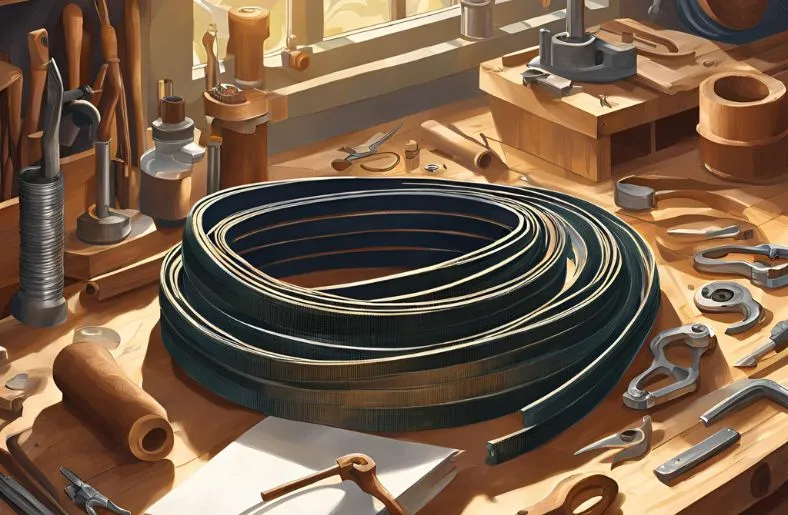Drive belts are the unsung heroes of machinery, transferring power between components in everything from industrial equipment to household appliances. While many assume belts only need replacement when worn, proper lubrication can significantly extend their lifespan and improve performance.
This guide on how to lubricate drive belt will walk you through the essential steps and considerations for drive belt lubrication, helping you maintain your equipment effectively.
Table of Contents
Drive Belt Basics
Before diving into lubrication techniques, it’s crucial to understand that not all drive belts require or benefit from lubrication. Modern V-belts and serpentine belts are typically designed to run dry, as lubricants can actually deteriorate their material and compromise their grip.
However, flat belts, particularly those made of leather or certain synthetic materials, often benefit from proper lubrication to maintain flexibility and prevent cracking.
When to Lubricate Your Drive Belt
Timing is everything when it comes to belt maintenance. Watch for warning signs that indicate your belt needs attention: unusual squeaking sounds, visible dryness or cracking, or decreased performance. For leather belts, apply lubrication when the surface feels dry or brittle to the touch. Synthetic belts may require lubrication based on manufacturer specifications or when showing signs of excessive wear.
Choosing the Right Lubricant
Selecting an appropriate lubricant is paramount to effective belt maintenance. Belt dressing products specifically formulated for your belt type are typically the safest choice. For leather belts, neatsfoot oil or specialized leather belt dressing works best.
Synthetic belts might require specific compounds designed for their material composition. Avoid using general-purpose lubricants like WD-40 or motor oil, as these can damage the belt material and attract dirt.
How to Lubricate Drive Belt: The Lubrication Process
Start by thoroughly cleaning the belt surface to remove any accumulated dirt or debris. A clean, lint-free cloth works well for this purpose. If dealing with stubborn grime, use a mild soap solution and ensure the belt is completely dry before proceeding with lubrication.
Apply the lubricant sparingly – excess application is one of the most common mistakes in belt maintenance. Use a clean cloth or applicator to spread a thin, even layer along the belt’s length. For rotating machinery, it’s often easier to apply the lubricant while manually turning the belt through several complete cycles, ensuring even coverage.
Special Considerations for Different Belt Types
Leather belts require special attention during lubrication. These traditional power transmission components need regular conditioning to prevent drying and cracking. Apply leather-specific lubricant every few months, or more frequently in dry environments. Work the lubricant thoroughly into the leather, paying particular attention to any visible stress points.
For synthetic belts that require lubrication, follow the manufacturer’s recommendations strictly. Some modern belt materials are engineered with specific surface characteristics that can be compromised by incorrect lubricant selection or over-application. When in doubt, consult your equipment manual or contact the manufacturer directly.
Maintenance Schedule and Best Practices
Develop a regular maintenance schedule based on your equipment’s usage patterns and operating environment. High-speed or heavily loaded applications may require more frequent attention. Keep detailed records of lubrication dates and any observed belt conditions to help establish optimal maintenance intervals.
Remember to inspect the entire drive system during maintenance. Check pulleys for proper alignment and wear, as misaligned or damaged pulleys can cause premature belt wear regardless of lubrication status. Clean pulley grooves regularly to prevent buildup that could affect belt performance.
Related Guide: How to Lube Caliper Slide Pins: The Complete Maintenance Guide (2025)
Safety Considerations
Always prioritize safety when performing belt maintenance. Ensure machinery is completely powered down and locked out before beginning any maintenance work. Wear appropriate personal protective equipment, including gloves to protect against chemicals in lubricants and any sharp edges on equipment.
Environmental Factors
Consider your operating environment when planning belt maintenance. High temperatures, excessive dust, or exposure to chemicals can all affect belt performance and lubrication requirements.
In dusty environments, minimal lubrication might be preferable as excess lubricant can attract and hold abrasive particles. In high-temperature applications, choose lubricants with appropriate temperature ratings.
Troubleshooting Common Issues
Even with proper lubrication, belts may sometimes exhibit problems. Excessive noise might indicate misalignment rather than lubrication issues. Slipping could result from over-lubrication rather than insufficient lubrication.
Learn to distinguish between lubrication-related problems and other mechanical issues to address problems effectively.
Conclusion
Proper drive belt lubrication is a crucial aspect of machinery maintenance that directly impacts equipment longevity and performance. By understanding your belt type, choosing appropriate lubricants, and following correct application procedures, you can significantly extend belt life and prevent costly downtime.
Remember that while lubrication is important, it’s just one component of a comprehensive maintenance strategy. Regular inspection, proper alignment, and timely replacement when necessary all contribute to optimal belt performance.

